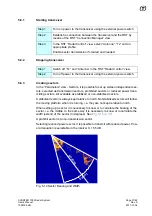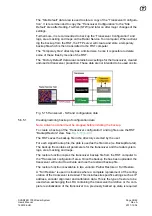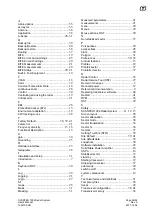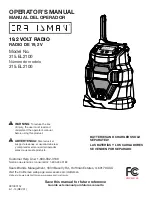
Page 51/62
Rev. A
2017-12-04
SCANTER 1002 Radar System
User’s Manual
1255194-HO
8
Technical terms and definitions
Accuracy
The difference between the average of repeated meas-
urements of the same quantity under identical conditions
and the known "true" value, i.e. the difference between the
average of the measurements of the range to a fixed ref-
erence target and the range value calculated from the
geographical coordinates of the reference target and
radar sensor.
Antenna
The upper rotating part of the antenna system. The anten-
na is radiating the RF power and receiving the echoes
from the targets. Depending on the antenna type the radi-
ating component can be a slotted waveguide or a horn
with belonging reflector.
Antenna Polarization
Antenna polarization is determined by the direction of the
electrical field. SCANTER 1002 is horizontally polarized.
Azimuth
The angle between a horizontal reference direction (north
or heading) and the horizontal projection of the direction
of interest, measured clockwise.
Doppler Effect
In radar technology the Doppler Effect is used for speed
measurement, among others. The Doppler Effect is the
apparent change in frequency or pitch when a moving tar-
get is hit by a radar beam. When a target is approaching
the radar, the target is "compressing" the beam in front of
it resulting in a higher frequency in the echo.
Encoder
Unit which provides information about the azimuth i.e. the
direction in which the antenna is pointing. For each rota-
tion the encoder sends a number of azimuth count pulses
(ACPs), typically 8192 pulses and one azimuth reference
pulse (ARP).
The encoder is included in a encoder assembly which nor-
mally holds one or two encoders.
Extractor
The extractor analyses the incoming video for plot creat-
ing plots. Furthermore, it calculates plot properties such
as area, intensity, centre of gravity, etc.
Frequency Diversity
Frequency Diversity (FD) is a sequential transmission on
two different frequencies which after processing increas-
es the signal quality by an increase of the signal-to-noise
ratio. The target is hit twice and behaves differently
depending upon the frequency of the electromagnetic
wave hitting it. Furthermore, if slotted waveguide anten-
nas are used, an additional advantage is achieved, name-
ly the time diversity.












































